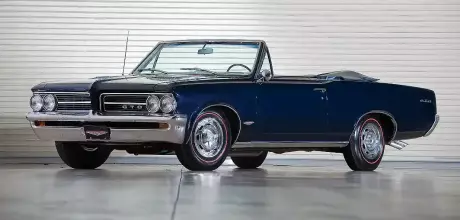60th Anniversary 1964 Pontiac GTO
Evans takes a look back at the legendary Pontiac GTO, which is celebrating its 60th Anniversary in 2024…
Across the pond
The premise was simple: Sidestep General Motors’ corporate edict that prevented engines larger than 330 cubic inches from being installed in intermediate cars by creating an option package for the mid-size Tempest two-door – one that included the big 389 cubic inch V8 found in Pontiac’s full-size line.
Additional features of the GTO package ran to three- and four-speed manual gearboxes, or a two-speed slush box, stiffer springs, a bigger front sway bar, seven-blade clutch fan, four-barrel carburetor, dual exhaust tips, twin non-functional hood scoops, wider wheels and special GTO and 6.5-litre callouts. The name itself, Gran Turismo Omologato, was borrowed from Ferrari, and translated means a grand touring car sanctioned for racing. Italian sportscar purists took umbrage at Pontiac using the hallowed moniker meant for a line of thoroughbred Ferrari 250s, yet in stock form the Pontiac GTO could match one in a drag race – its 325 horsepower big-bore V8 enabling it to accelerate from 0-60 mph in well under seven seconds, even if it could not match a 250 GTO in the turns.
Then again, that wasn’t the point – the Pontiac GTO was all about Saturday night stoplight to stoplight action and thrashing through the quarter mile on Sunday. An optional Tri-Power intake offered three-two-barrel carburetors, bumping engine output to 348bhp. Pontiac had planned to sell just 5000 GTOs for 1964, but demand totalled more than 32,400.
For its sophomore season, the Tempest gained crisp new styling updates, including stacked headlights, while the GTO offered a new hood scoop, special grilles and badging, as well as an even hotter engine (335bhp in four-barrel trim, 360bhp with Tri-Power). Sales zoomed to 75,352 units, proving that Pontiac had a sure-fire winner on its hands. By this stage, the American Supercar (muscle car) craze was underway with rival GM divisions, as well as cross-town competitors Ford, Chrysler and even American Motors getting in on the action.
Yet it was the GTO that remained the front runner. For 1966, GM rebodied its intermediate cars and the Pontiac Tempest got a larger, curvier body with pronounced coke-bottle contours and a tunnelled back window. The GTO was now a separate model, instead of an option package, and got unique plastic grilles and fluted tri-bar taillight lenses. The 1966 model proved to be a high watermark, setting a one-year production total for a factory muscle car that has never been beaten – 96,946 units sold. While the GTO continued to up the ante in the performance department, thecompetition was catching up, with other GM divisions, notably Chevrolet and Oldsmobile, making inroads with the Chevelle SS and 4-4-2. Meanwhile, Chrysler began dishing out ever snazzier iterations of its hot Dodge and Plymouth intermediates, such as the 383 and 426 equipped Coronet, Charger and Satellite.
A third generation GTO arrived for 1968, on a shorter wheelbase, featuring the option of hidden headlights and an industry first: a rubberized plastic energy-absorbing ‘Endura’ front bumper. By this stage, the standard engine was a 400 cubic inch V8 cranking out 350 horsepower, with an optional Ram Air II setup offered from mid-year, which added freer-breathing round-port cylinder heads, more aggressive camshaft and functional air induction. In terms of performance, 1969 and 1970 were the zenith years for the GTO, as they were for factory American muscle cars in general.
The glitzy Judge debuted for 1969, offered in high impact colours, with special graphics and badging. The Judge came equipped with the new Ram Air III 400 V8 that made 366 horsepower and could be teamed with a four-speed manual that included a Hurst shifter (an even hotter 370hp Ram Air IV was available, though few Judges or indeed GTOs were ordered with it). The following year, all GM intermediate cars got a facelift and the GTO looked even more muscular. It also had the performance to back up its looks with an optional 455cu in H.O. V8 rated at 360bhp and a walloping 500lb-ft of torque (strangely, this engine was not offered in that year’s Judge). Even at this point, the GTO’s days were numbered. The bloom was off the rose as far as muscle cars were concerned…
By 1972, the GTO had reverted to option package status once again and by 1974 was gone altogether – bowing out as a hotter version of the compact Ventura. While the GTO enjoyed a short revival during the 21st century, as an Americanized version of the Australian Holden Monaro, for me, the original stands as perhaps the definitive American muscle car. Sure, there were faster and more exotic examples built, but the GTO somehow captures the true essence of the factory hot rod era. Every time I see one on the road, at a show or racing event, I always need to get a closer look. It’s also why the nagging desire to own a 455-powered 1970 or ’71 Goat has remained a constant. Which means that at some point, probably over the next few years, I will have to put my money where my mouth is. I’ll let you know how that goes. In the meantime, I’d just like to say Happy Anniversary GTO, the automotive landscape is a better and richer place because of you!
The original: 1964 Pontiac GTO.


